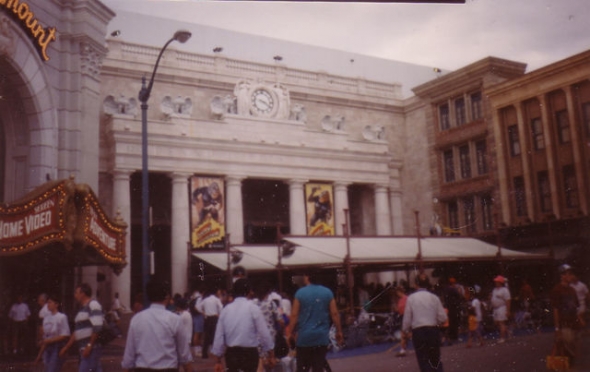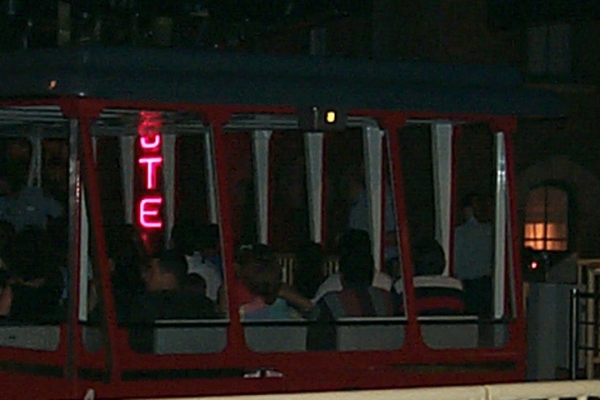Ride experience
Naturally, every ride is a bit different, with its own storyline, vehicles, and technology. However, as one of Universal Studios Florida’s original Big 3 attractions, along with Earthquake and Jaws, Kong set the stage for later attractions to follow. With that in mind, take a moment to relive the full ride experience.
It began as you entered the stunningly detailed queue, which was designed to resemble a Manhattan subway station and city block. Real graffiti artists from New York were brought in to create elaborate works of art, to which an endless stream of park guests added their own signatures and drawings as they waited. A series of TV monitors set the stage with news reports by then-current real life anchors. These details, along with the incredibly realistic replicas of more than 50 Lower East Side buildings, truly anchored your experience in space and time.
As a ride operator at Universal, you will be expected to memorize and understand the details of your attraction. Guests can and will test your knowledge every day, asking in-depth questions about the most obscure hidden secrets, so make it your mission to learn as much as possible.
Pro tip: Never fake it. If you don't know the answer to a question, find out from someone who does. Inventing a great story might seem like a good idea at the time, but will only make you look ridiculous and untrustworthy. In addition, not only does Universal employ "mystery guests," but high-level managers have been known to make undercover appearances. Making something up could get you fired on the spot.
Rotations and break system
At the theme parks, every work location has its own system of rotations and breaks. Employees rotate through a series of positions, followed by a break of a designated length. This keeps everyone fresh, and avoids the glassy eyes and tendency to zone out that can occur when standing in one spot for a long time. I have consistently found, however, that spiel attractions have the best rotations.
In my opinion, the 1992 Kong system was the best of the best. Unless we were short staffed or something unusual was going on, each rotation had three positions: two non-spieling spots and a tram. We were at each position for 15 minutes (3 tram cycles) before moving on to the next. This meant working for 45 minutes before going on break for 15…not a bad schedule, in my opinion.
Lunches were officially 30 minutes long, but most of the time everyone in a rotation agreed to 45s. So even if everyone ahead of you took lunch on the same rotation, you would work 2 hours and 15 minutes before taking your own 45 minute lunch.
At Kong, the non-spieling positions included Queue 1 through 3, Pre-board, Load 1 and 2, Unload 1 and 2, and Tower, and we had 4 trams. In general, these positions have not changed much over the years. Queue 3 gave way to Express Entrance, and each ride has specific duties, but the positions are very similar across all rides at all theme parks today.
Queue 1 is the attraction’s greeter, and is responsible for maintaining the queue ropes and rails. Queue 2 was my favorite, as it handles VIPs and special guests who use the back entry. Queue 3 was only staffed on very busy days, as it covered the extended queue. Though it is hard to believe today, we sometimes had a line upwards of 2 hours long—and there was no such thing as an Express Pass!
Load positions are generally responsible for boarding guests onto trams, making sure their laps are clear of all items that could interfere with the lap bars, closing the load doors, and making a final safety check before dispatch. Likewise, the unload positions are responsible for getting guests off the trams and out the exit, closing the unload doors on the tram, and helping Load conduct safety checks. Unload 1 also counts and logs the number of guests on each vehicle. In addition, Load and Unload have to coordinate to save rows for VIPs boarding from the back entrance.
Pre-board is another fun position. Standing at the top of the queue ramp, Pre-board is responsible for asking guests how many people are in their party and assigning them to the correct rows. At Kong, it required a certain level of diplomacy, though, because larger guests could not fit under the regular lap bars, so we had to assign them to the back row, where there was significantly more room. I had more than a few awkward conversations with larger guests who wanted to sit up front, although most were very nice and understanding. You might run into similar situations at the roller coasters, where specific seats are assigned to guests who need a bit more room.
It is not unusual for the day’s team members to work together to create and staff each day’s rotations. For example, if someone who is not yet spiel-trained is working, that person might be frozen in a specific non-spieling position, with someone providing periodic breaks during the day. On the other hand, if a few people without spiel training are on duty, you might create a non-spiel rotation that functions as normal. It is all very loose and friendly, and everyone generally gets what they want.
Accommodating guests with disabilities
The Americans With Disabilities Act was passed in 1990, but theme parks were given time to come into compliance with its provisions. Prior to our compliance date, we were not wheelchair accessible. To become compliant, the system had to be reprogrammed to have the trams sit level with the load and unload platforms. The trams also had to be retrofitted with foldable rear seats and wheelchair securing clamps.
Then there was the issue of how to get wheelchairs from ground level to the ride. The queue ramps were steep, with sharp turns, and our VIP entrance involved three flights of stairs. But, the exit ramps were not quite as steep or sharply banked, and they were significantly wider than the queue ramps.
So Queue 2, previously a cakewalk position, gained a new task—pushing wheelchairs up the exit ramp! Unload 2, previously an extra position used only on busy days, became the wheelchair loader. We all learned to strap down wheelchairs, securing them against the ride’s bounces and dips, within the 30 seconds allotted for each dispatch. There was definitely a learning curve for everyone, and we truly appreciated how kind and patient our wheelchair-using guests were with us as we figured out how best to accommodate them.
Today, of course, accommodating guests with disabilities is all part of a day’s work. Even Kong’s replacement, Revenge of the Mummy, now has an elevator. You will learn the specific procedures for your attraction, including transfer requirements and things you might be able to do to assist, such as slowing a moving walkway.


Add new comment